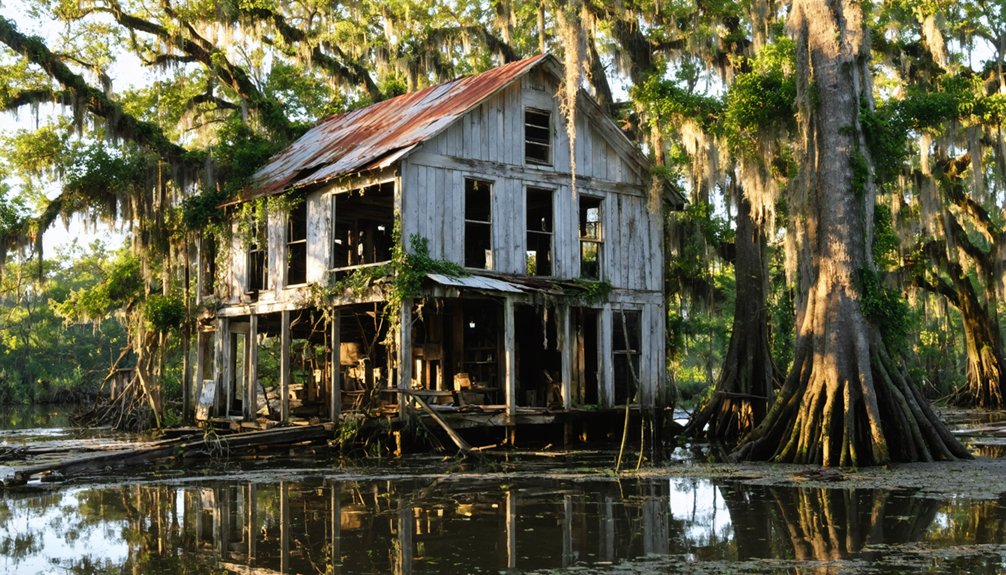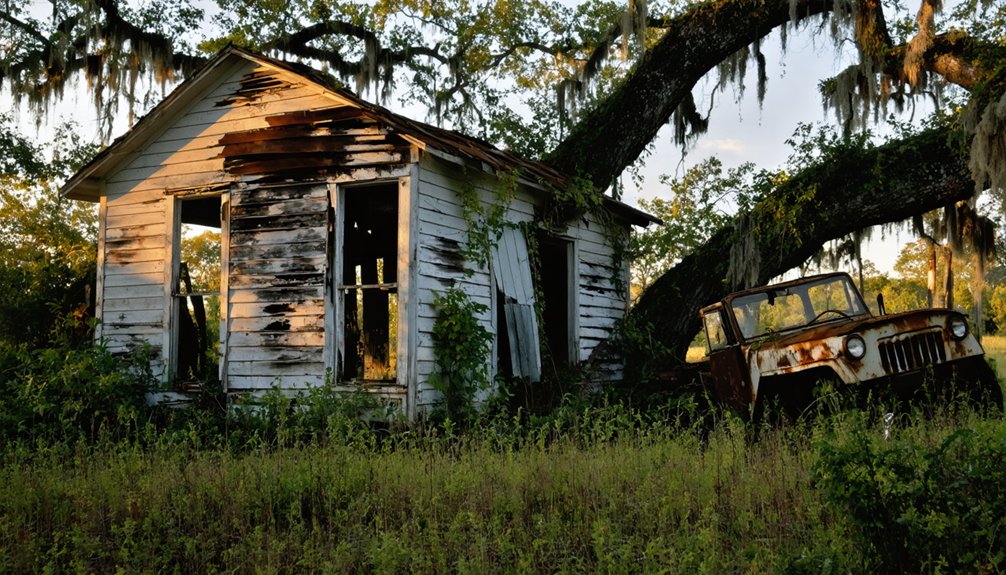You’ll find Torras’s haunting remains in Louisiana, where it once flourished as a strategic railroad hub at the confluence of three major rivers. Founded in the early 1900s, this promising boomtown met its demise through the devastating Great Flood of 1927, which submerged streets under 6 feet of water. When the railroad relocated and the Great Depression hit, Torras’s fate was sealed. The ghost town’s story holds significant lessons about nature’s power over human ambition.
Key Takeaways
- Torras emerged as a railroad boomtown in early 1900s Louisiana, strategically located at the intersection of major waterways and rail lines.
- The Great Flood of 1927 devastated the town’s infrastructure, with floodwaters reaching six feet and displacing thousands of residents.
- Following the flood’s destruction, the railroad’s decision to relocate dealt a fatal blow to Torras’s economic viability.
- The combination of flood damage, railroad departure, and Great Depression led to complete abandonment of the once-thriving transportation hub.
- Today, Torras exists only in historical records, serving as a cautionary tale about environmental vulnerability and overdependence on single industries.
The Birth of a Railroad Boomtown
As the Texas & Pacific Railroad carved its path through Louisiana in the early 1900s, Torras emerged at a strategic confluence of the Mississippi, Atchafalaya, and Red rivers. You’d have witnessed a flurry of activity as construction crews laid tracks, setting up temporary camps that soon transformed into permanent settlements.
The railroad history of Torras began with ambitious plans, as all four major Louisiana railroads projected to intersect at this promising location. Much like the Erie Canal’s completion in the east, this new infrastructure promised to revolutionize transportation and commerce in the region. The development mirrored other successful rail ventures like the Crowell & Spencer operation established in 1905.
The town development accelerated rapidly, with merchants and entrepreneurs flocking to capitalize on the new rail stop. You’d have seen freight stations, warehouses, and repair shops sprouting up along the tracks, while hotels and restaurants catered to the growing workforce.
Torras’ position as a multimodal transport hub seemed assured, promising freedom of movement and economic prosperity.
Natural Forces Reshape Destiny
While Torras initially thrived as a railroad hub, nature would ultimately determine the town’s fate.
You’ll find the town’s downfall began with the devastating levee break of 1912, revealing the inadequacy of local flood mitigation efforts. But it was the Great Flood of 1927 that dealt the killing blow, destroying much of Torras’s infrastructure and forcing many residents to abandon their homes.
The town’s environmental resilience was further tested by its challenging location amid wetlands and flood-prone terrain. Following the flood’s destruction, the town made attempts at a moderate rebuild before facing its final decline.
Built in a precarious position between swamps and floodplains, the town struggled against nature’s constant challenges.
Like the fate of Holland Island’s collapse, Torras showcases how rising waters can completely erase a community’s existence.
When the railroad relocated, you could see Torras’s economic lifeline vanish. The combination of repeated flooding, insufficient resources for rebuilding, and the mounting costs of maintaining infrastructure in such hostile conditions made recovery impossible.
Today’s rising sea levels and intensifying storms serve as stark reminders of nature’s power over human settlement.
The Great Floods That Changed Everything
The Great Flood of 1927 struck Louisiana with unprecedented force, triggering multiple levee failures that would reshape Torras and the surrounding Delta region forever.
You’d have witnessed floodwaters rising at unprecedented rates as the Mound Landing crevasse collapsed, sending destructive currents through the Tensas Basin where Torras stood. Water depths reached up to 6 feet in many areas, forcing tens of thousands to abandon their homes with little more than what they could carry. The Red Cross served 50,000 meals daily to displaced residents seeking aid.
The flood’s devastating reach extended nearly fifty miles wide across Northeast Louisiana, transforming the landscape into an inland sea. The disaster exposed harsh realities about flood preparedness and community resilience, as poor rural residents faced disproportionate impacts.
While some found refuge with relatives, many others endured segregated shelters in New Orleans. The flood’s psychological scars would linger long after the waters receded, fundamentally altering the region’s social fabric and spurring major changes in flood control legislation.
Economic Collapse and Abandonment
Following the devastating floods, Torras’s economic foundation crumbled when the railroad company redirected its routes away from the town in the late 1920s.
The town’s heavy dependence on shipping and rail transport exposed its economic vulnerabilities, leaving it defenseless against broader market shifts. Similar to how industrial development encroached on communities like Mossville in the 1940s, drastically altering their economic landscape.
You’d have witnessed a rapid domino effect as transportation shifts dealt multiple blows to the local economy. The Great Depression intensified the town’s struggles, while repeated flood damage made infrastructure maintenance costs unbearable.
Local businesses shuttered one by one as trade dwindled, and workers sought opportunities elsewhere. With its once-bustling port facilities idle and rail lines silent, Torras couldn’t sustain itself.
The lack of economic diversification, combined with the region’s industrial decline, sealed the town’s fate, transforming it from a strategic hub into an abandoned shell.
Legacy of a Lost Louisiana Town
Remnants of Torras’s existence now live primarily through historical records and flood management lessons, though you won’t find any physical structures marking its former location in Pointe Coupee Parish.
The town’s legacy endures through historical preservation efforts documenting its vibrant Catholic community and transportation heritage. Founded by immigrant Joseph Torras, the town represented ambitious dreams of creating a thriving commercial hub. The area’s rural character remains unchanged even today, with agricultural fields stretching across the landscape.
The community resilience of Torras’s story teaches lasting lessons through:
- The “Torras Crevasse” event that reshaped regional flood control policies
- Joseph Torras’s pioneering vision of combining rail and river commerce
- The town’s diverse Catholic parish life, preserved in church records
- Its cautionary tale about environmental vulnerability along the Mississippi
Today, Torras’s memory influences modern flood management strategies and reminds us how natural forces can reshape communities, despite their economic potential and cultural significance.
Frequently Asked Questions
What Happened to Joseph Torras After the Town’s Abandonment?
Picture a fading historical figure – that’s Joseph Torras’s fate. You won’t find records of his life after the town’s decline. His legacy vanishes from parish documents post-1927, leaving his final story untold.
Are There Any Surviving Photographs of Torras Before Its Destruction?
You won’t find verified photographs from Torras’s early days, despite historical preservation efforts. While ghost town photography exists for other Louisiana settlements, no confirmed images of pre-destruction Torras have been publicly documented.
How Many People Lived in Torras During Its Peak Population?
While no exact census records exist, you’ll find the ghost town of Torras likely peaked at several hundred residents during its early railroad days, before floods and economic decline emptied the promising settlement.
Did Any Original Torras Families Remain in Pointe Coupee Parish?
You’ll find limited evidence of Torras descendants remaining in Pointe Coupee history after Joseph Torras’s era. While the town bears their name, records don’t show significant family presence continuing in the parish.
What Specific Crops Were Grown on the Plantations Around Torras?
Sweet as sugar and white as snow, you’d have found expansive sugar cane fields dominating the landscape, with cotton cultivation serving as a secondary crop. Corn and pecans provided additional income.
References
- https://raregoldnuggets.com/?p=3886
- https://www.morleymarina.com/town
- https://k945.com/these-3-louisiana-ghost-towns-are-just-a-road-trip-away/
- https://achahistory.org/wp-content/uploads/2019/10/Pasquier_ACHA-Seminar_draft.pdf
- https://www.loquis.com/en/loquis/6480361/Torras+Louisiana
- https://en.wikipedia.org/wiki/List_of_ghost_towns_in_Louisiana
- https://en.wikipedia.org/wiki/Torras
- https://kids.kiddle.co/Torras
- https://www.onlyinyourstate.com/trip-ideas/louisiana/underwater-ghost-town-la
- https://historicpath.com/article/introductory-history-first-rail-road-boomtown-578



